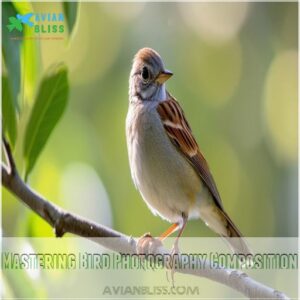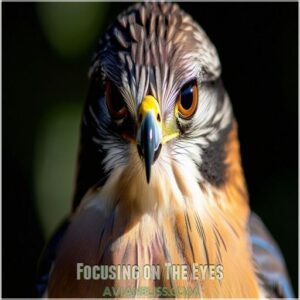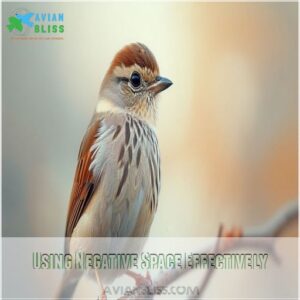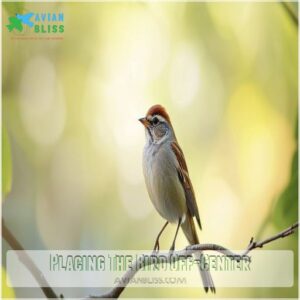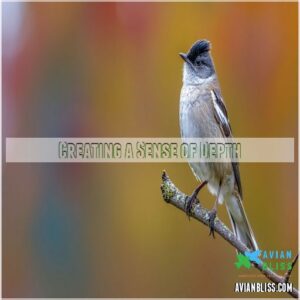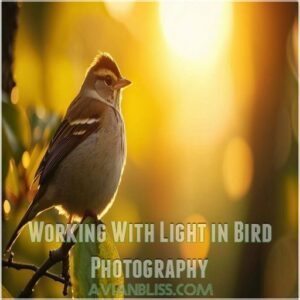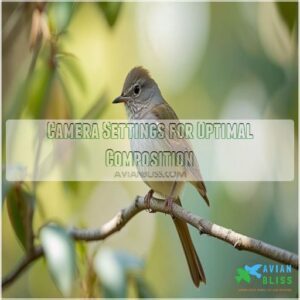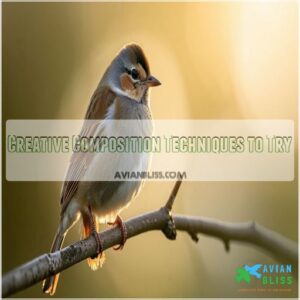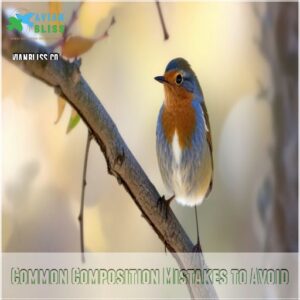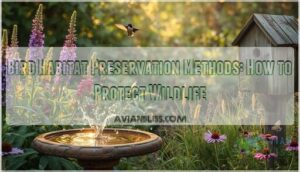This site is supported by our readers. We may earn a commission, at no cost to you, if you purchase through links.
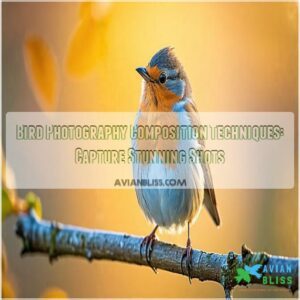
Embrace the rule of thirds, placing your feathered friend off-center to add dynamism.
Use leading lines, like tree branches, to guide the viewer’s eye right to the star of the show.
Don’t be afraid to experiment with angles—sometimes, you gotta get a little muddy for the perfect shot!
Capture bird behavior or the very moment a bird takes flight to tell a compelling story.
Now, ready to snap photos that make others tweet with envy?
There’s plenty more to discover for truly impactful shots.
Table Of Contents
- Key Takeaways
- Mastering Bird Photography Composition
- Bird Photography Composition Techniques Explained
- Visual Storytelling in Bird Photography
- Composition Tips for Bird Portraits
- Working With Light in Bird Photography
- Camera Settings for Optimal Composition
- Creative Composition Techniques to Try
- Common Composition Mistakes to Avoid
- Post-Processing for Enhanced Composition
- Building a Portfolio With Impactful Bird Photos
- Frequently Asked Questions (FAQs)
- What are some good compositional techniques for bird photography?
- How do you create compelling bird photography?
- What is bird photography composition?
- What are the rules for composing Bird photographs?
- How do you make a bird a good photo?
- How do you compose a bird photograph?
- Which AF method is best for bird photography?
- What is the rule of thirds in photography birds?
- How do you get sharp pictures in bird photography?
- Which mode is best for bird photography?
- How can I effectively use negative space?
- What are the best backgrounds for bird photography?
- How does focal length impact composition?
- Can weather conditions influence composition choices?
- What role does bird behavior play in composition?
- Conclusion
Key Takeaways
- Use the rule of thirds to position birds off-center for more dynamic compositions and enhance visual interest.
- Pay attention to lighting, especially during golden hours, to capture vivid colors and natural shadows that enrich your photos.
- Experiment with angles, leading lines, and negative space to guide viewers’ eyes and add depth and perspective to your shots.
- Consider bird behavior to anticipate movements, allowing you to capture engaging action shots and tell powerful visual stories.
Mastering Bird Photography Composition
When you’re snapping photos of birds, mastering composition can transform your shots from ordinary to extraordinary, making that sparrow look like the king of its habitat.
Embrace techniques like the rule of thirds and leading lines, and you’ll find your bird photos capture the moment but tell a vivid story that keeps viewers captivated.
Essential Elements of Composition
Think of bird photography like crafting a beautiful painting. To create a masterpiece, start by setting up a welcoming environment for your subjects, such as using bird baths and feeders.
Balance and simplicity are your best friends—let the bird shine without cluttered backgrounds.
Depth and perspective add magic, drawing viewers into the scene.
Keep it real, but don’t be afraid to play with angles for unique shots.
Remember, a well-composed photo tells a story without words.
Rule of Thirds in Bird Photography
A powerful composition tool, the rule of thirds helps you create bird portraits that pop.
Imagine dividing your viewfinder into thirds both horizontally and vertically.
Place your bird off-center, at one of the intersections—it instantly creates visual balance.
This simple technique avoids a dull, centered subject and adds intrigue to your bird photography.
Experiment! You’ll see how much more dynamic your images become.
Leading Lines and Framing
Consider using leading lines to guide your viewer’s eye straight to the bird, creating depth and focus within your composition.
Frame your shots by incorporating elements in the foreground and background to add perspective.
Imagine capturing a robin through the branches of a tree—this adds layers and draws the viewer into the scene naturally.
Symmetry and Patterns
After seeing how leading lines frame your bird captures, let’s talk about symmetry and patterns. Nature’s balance, like birds in symmetrical flight or the repeating shapes of feathers, adds harmony to your shots.
- Align shots for symmetrical appeal.
- Highlight bird patterns, like flight formations.
- Capture reflections in still water.
- Use pattern recognition to spot unique behaviors.
Bird Photography Composition Techniques Explained
You’ve explored key elements of composition, now it’s time to unpack specific techniques.
Let’s start with framing. Framing is like creating a protective shell around your subject, helping direct attention precisely where you want it.
Combine this with perspective, and you’ve got the secret sauce for more engaging photos. Getting down low or finding a unique angle brings depth of field into play, helping separate your feathered subject from distracting backgrounds.
When creating this depth, consider the golden hours, like dawn and dusk photography, to capture soft, warm light and active birds.
Speaking of backgrounds, keep them simple to highlight the bird. Stray branches, bright patches, or even curious onlookers can steal the spotlight.
Harness bird movement by capturing wing flaps or a quick takeoff, adding dynamism to your shots.
Remember to think with a photographer’s eye, searching for that magical balance of light and shadow. Master these techniques, and you’ll be snapping pictures that sing more melodiously than a dawn chorus.
Visual Storytelling in Bird Photography
In bird photography, you’re not just snapping pictures—you’re crafting stories that bring feathers and flight to life.
By capturing their quirky behaviors and vibrant habitats, you’ll create images that sing with emotion and adventure.
Capturing Bird Behavior and Action
In bird photography, capturing motion and action poses is all about timing and patience.
Birds in flight can offer breathtaking shots, like watching a ballet unfold in the air.
Understanding species behavior and nesting habits helps predict their next move, turning you into a wildlife detective.
So, grab your camera and catch those incredible moments of avian acrobatics!
Conveying Emotion and Personality
Bird photography isn’t just about feathers; it’s about stories. Capturing a bird’s expression can reveal a world of wonder.
- Bird expressions: Focus on unique poses or gestures to convey mood.
- Body language: Catch moments of interaction or curiosity.
- Eye contact and lighting: Use light to highlight the bird’s gaze, making your viewer feel connected.
Showcasing Habitat and Environment
Showing a bird’s personality is great, but don’t forget its home! The background adds context; a vibrant rainforest tells a different story than a snowy field.
Think about the lighting—a golden hour sunset paints a magical scene.
Good composition makes all the difference.
| Background Element | Lighting Condition | Composition Tip | Storytelling Impact |
|---|---|---|---|
| Lush forest | Soft morning light | Rule of thirds, leading lines | Emphasizes natural habitat |
| Rocky coastline | Harsh midday sun | Silhouette, strong contrast | Highlights ruggedness |
| Open field | Overcast sky | Wide shot, shallow depth of field | Shows vastness and freedom |
| Dense thicket | Golden hour | Close-up, focus on details | Creates intimacy and mystery |
Experimenting With Angles and Perspectives
Shift your perspective and capture unique angles in bird photography.
Try a bird’s-eye view for a majestic feel or low-angle shots to make your subject seem larger than life.
Creative framing sprinkles a twist into your shots—think outside the box!
Experimenting with perspective shifts reveals unexpected beauty, turning ordinary scenes into extraordinary masterpieces that tell a compelling story.
Composition Tips for Bird Portraits
Capturing the perfect bird portrait is all about focusing on those enchanting eyes and letting their charm shine through.
Don’t be afraid to play with negative space or place the bird off-center, creating depth that draws viewers into the scene.
Focusing on The Eyes
When capturing bird portraits, focusing on the eyes brings your subject to life.
This sharpness draws viewers in, making the eye contact with the bird gaze truly engaging.
Set your camera’s focus points directly on the bird’s eyes, keeping an eye on pupil size to enhance expression.
It’s the secret to creating a portrait that sings.
Using Negative Space Effectively
In bird portraits, using negative space effectively is like giving your subject room to breathe.
This minimalist approach creates a stunning isolation effect, letting the bird shine without distractions.
Try these tips:
- Embrace background blur to emphasize your subject
- Use space for emotional impact and storytelling
- Highlight subject focus for better engagement
Negative space can transform a simple shot into a masterpiece.
Placing The Bird Off-Center
So you’ve mastered using negative space; now let’s talk about placing the bird off-center.
This technique spices up your photos with balance and visual interest.
By following the rule of thirds, you’re keeping it fresh and engaging.
Imagine lines guiding your bird into the limelight, leaving no chance for bland shots.
Embrace the unpredictability and observe the difference!
Creating a Sense of Depth
After placing your bird off-center, give your photos a sense of depth by playing with background blur and including foreground elements.
Considering the best camera settings, such as Aperture Priority mode, to achieve the desired depth of field and background blur as described in bird photography techniques.
Layering helps create perspective, making your image more engaging.
Use depth of field to focus on the bird while softly blurring the surroundings.
This technique adds dimensionality and life to your shots, capturing viewers’ imaginations.
Working With Light in Bird Photography
Lighting’s key to amazing bird photos; let’s learn how to use it to your advantage!
Golden hour light creates magic,
and how to avoid harsh midday sun for stunning, vibrant shots.
Golden Hour and Soft Light
Golden hour’s charm is like nature’s perfect selfie lighting—birds look their absolute best. You’ll see vibrant colors and soft shadows that accentuate their finer details.
Try these tips:
- Use warm light to highlight feathers.
- Capture bird action in slow motion.
- Choose low ISO for vivid shots.
- Adjust camera settings for golden hues.
- Explore light direction for drama.
Avoiding Harsh Midday Sun
The midday sun might feel relentless, but you can dance around it with a few tactics.
Seek the shade of trees or use a diffuser to soften harsh light.
Early mornings offer a gentler glow, perfect for capturing bird beauty.
Embrace dappled light for natural highlights, like nature’s spotlight.
Remember, overcast days also offer soft, flattering light minus the sun’s intensity.
Utilizing Overcast Skies
Even under overcast skies, you’ll find a hidden gem: diffused light.
This type of light softens shadows and enhances details, creating a balanced exposure that’s a photographer’s dream.
Imagine capturing those intricate bird feathers with just the right amount of detail.
Embrace these conditions, and you’ll end up with stunning, well-composed shots every time.
Enhancing Colors and Textures
When you’re out shooting on overcast days, enhancing those colors and textures is key.
Pay attention to how light affects feather detail and color saturation.
Use background contrast to make the bird pop.
You can find a range of bird photography editing software to help with this.
A few tweaks:
- Boost shadows: Add depth to feathers.
- Adjust whites: Brighten without losing texture.
- Enhance clarity: Make details striking.
Camera Settings for Optimal Composition
To capture birds in their natural elegance, you’ll want to master camera settings like aperture, shutter speed, and ISO, which play key roles in composition.
Think of your camera as a trusty sidekick, ready to toggle autofocus for crisp shots of feathered friends mid-flight, while burst mode makes sure you won’t miss a beat in the action-packed avian world.
Autofocus Settings for Birds in Flight
Capturing birds in flight is thrilling, but your autofocus settings are key.
Always use continuous autofocus mode to track these unpredictable creatures, adjusting your focus sensitivity to -2 for busy backgrounds as recommended in bird photography tips.
Pair it with burst mode for rapid shots.
Set your focus area to wide, giving that bird no escape.
Before you know it, you’ll have a gallery of stunning, dynamic bird shots that feel alive.
Aperture and Shutter Speed Control
So, you’ve nailed autofocus; now let’s talk aperture and shutter speed.
These settings are your secret weapons!
Choose: 1. Aperture priority mode for controlling depth of field; 2. Shutter priority mode to freeze motion or create motion blur; or 3. Manual mode for ultimate control.
Understanding bird behavior, like the unique courtship displays of the Ruby-throated Hummingbird, and mastering backyard birds of Vermont can greatly enhance your shots. Mastering these opens up stunning bird photos.
ISO and White Balance Settings
Tuning your ISO sensitivity and mastering white balance basics can make your bird photos pop! Consider adjusting your camera settings with the right equipment from an ISO for bird photography store. ISO Sensitivity White Balance Basics Shooting in RAW —
Burst Mode and Continuous Shooting
Switch gears from ISO settings using burst mode and continuous shooting to capture fast-moving birds with precision.
Think of it as your camera’s superpower for freezing motion.
Here’s how:
- Enable burst mode for rapid shots.
- Set high shutter speed to freeze motion.
- Keep focus on birds in flight.
- Balance image quality to avoid noise.
Creative Composition Techniques to Try
Don’t be afraid to think outside the box and experiment with creative techniques that can add a unique flair to your bird photography.
Try capturing motion blur for dynamic images, embracing backlighting for stunning silhouettes, or play with reflections to make your shots truly stand out.
Panning and Motion Blur
Mastering camera settings isn’t enough—you’ve gotta embrace panning and motion blur.
To increase your chances of capturing stunning shots, research local bird species and their habits through seasonal bird behavior guides.
This technique lets you portray motion, keeping your bird in focus while the background blurs into an artistic swoosh.
Use a steady hand and medium shutter speed.
Pick subjects with predictable movements.
It’s like painting with your camera—practice panning speed and blur effect to capture stunning motion.
Intentional Camera Movement
Think bird photography’s all static shots. A good starting point is to understand the bird photography equipment checklist Equipment for Stunning Shots, including the right cameras and lenses, to freeze those perfect moments? Think again!
Intentional camera movement lets you turn ordinary scenes into abstract art.
By slightly moving your camera during a shot, you can create creative effects like dynamic motion blur, adding an artistic twist.
It’s like painting with light!
Don’t be afraid to experiment—surprising results and mesmerizing blurred backgrounds await.
Silhouettes and Backlighting
In the dance of dawn or dusk, capturing bird silhouettes offers dramatic flair.
Use creative backlighting to highlight backlit feathers and create striking silhouettes.
Here’s how:
- Golden Hour Timing: Aim for early morning or late afternoon for softer light.
- Position the Sun: Keep it behind the bird.
- Adjust Exposure: Slightly underexpose for rich, dark silhouette shapes.
Reflections and Water Effects
Let’s move from shadowy silhouettes to sparkling water! Reflections offer a whole new perspective. Imagine a heron mirrored perfectly, doubled in a still pond. That’s magic! Water adds depth and visual interest to your bird photos.
Here’s how to make it work:
| Water Type | Bird Behavior | Composition Tip | Feeling Evoked | Photo Example |
|---|---|---|---|---|
| Calm lake | Peaceful resting | Reflecting bird, clean lines | Serenity, stillness | Heron at sunset |
| Rippling stream | Dynamic movement | Blurred reflection, action | Energy, excitement | Kingfisher diving |
| Ocean waves | Coastal birds | Partial reflection, contrast | Power, vastness | Gull on crashing wave |
| Puddle | Small birds drinking | Close-up, tiny reflection | Delicate, intimate | Robin drinking |
| Waterfall | Birds near water | Misty reflection, bokeh | Majestic, mystical | Birds near falls |
Common Composition Mistakes to Avoid
Let’s face it, we’ve all had that awkward moment when a photo turns out more "oops" than "wow" because we centered the bird or ignored the lighting.
By avoiding these common mistakes, you can transform your bird photography from frustrating to fabulous, capturing the grace and beauty of your feathered subjects every time.
Centering The Bird
Ever wonder why centering a bird in your photos might feel a bit off?
While symmetry has its charm, placing the bird dead center can make images look static.
Bird portraits need dynamic balance.
Instead, try offsetting the focal point.
This technique highlights bird behavior and flight shots, giving your composition a lively twist.
Experiment and see the difference!
Not Considering The Lighting
Missing the mark on lighting can spell disaster for your bird photos.
Harsh light creates deep shadows, while midday intensity risks overexposed shots.
Instead, seek the magical hues of the golden hour.
Play with backlighting to spotlight feathers and capture intricate details.
Not considering lighting can turn a masterpiece-in-the-making into merely an uninspiring image.
Failing to Experiment and Adapt
Don’t get stuck in a rut by sticking to routines or resisting change.
Bird photography thrives on creativity.
Ignoring feedback or avoiding new gear limits your growth.
Embrace challenges; they’re your best teachers.
Adapt by trying new angles or experimenting with lighting.
Remember, capturing that stunning shot often means daring to stray from the beaten path.
Post-Processing for Enhanced Composition
Harness the power of post-processing to bring your bird photos to life, using techniques like RAW processing and strategic cropping for better composition.
RAW processing and strategic cropping can transform your shots into stunning visual stories.
Whether enhancing colors or tweaking textures, you’ll be amazed at how a few tweaks can transform your shots into stunning visual stories.
RAW Processing and Local Adjustments
Missed an outstanding shot because of poor exposure or colors? RAW file adjustments are your secret weapon, my friend.
With exposure correction and color grading, you can bring out the best in your bird photos.
Try selective sharpening to highlight feathers and noise reduction to keep things smooth.
Post-processing isn’t cheating—it’s like adding spice to your photography stew!
Advanced Techniques for Composition
After tweaking your RAW files, let’s explore advanced composition techniques.
Mastering Depth of Field adds impact; a shallow Depth of Field isolates your bird, while a deep one showcases its environment.
Experiment with different Perspectives – get low to the ground for a unique angle.
Remember the Rule of Odds for a more natural feel.
Use Negative Space creatively; it’s not wasted space, but a powerful tool.
Cropping and Resizing Images
Fine-tuning your bird photos often starts with resizing and cropping.
Think of your photo as a digital canvas, adjusting to enhance the story your image tells.
Consider:
- Image aspect ratios for balanced composition.
- Resolution considerations to maintain clarity.
- Batch processing tools to save time.
Good cropping elevates composition, letting key details shine.
Color Grading and Texture Enhancement
Boost color grading and texture enhancement in bird photos for stunning shots.
Highlight feather detail by adjusting saturation and contrast, making colors pop.
To capture such vivid colors, practice photographing birds against a bright sky by utilizing spot metering and shooting in RAW format.
Picture editing is like seasoning food: too much spoils, just enough enhances.
Share your results to delight or dazzle viewers!
| Color | Texture | Detail |
|---|---|---|
| Vibrant | Rich | Feather |
| Warm | Smooth | Plumage |
| Deep | Clear | Patterns |
Building a Portfolio With Impactful Bird Photos
Creating a portfolio that truly shines in bird photography isn’t just about having the sharpest shots—it’s about telling stories that captivate.
Start by curating your best work; include images that showcase the birds but also their behaviors and environments, and don’t forget to invest in the right bird photography gear to make sure your shots are of the highest quality.
Keep up with bird photography trends to make your portfolio feel fresh and relevant.
Use impactful storytelling to draw viewers in; let them feel the rush of a bird mid-flight or the serenity of a quiet perch.
As you refine your editing workflow, understanding that birds possess tetrachromatic vision capabilities helps you appreciate the nuances of their colors, and highlight the vibrant colors and textures that make each bird unique.
Remember, variety is key: mix portraits with action shots to keep things dynamic.
Don’t shy away from experimenting with angles or playing with light.
A well-rounded portfolio attracts clients and also serves as proof of your creativity and passion for this beautiful art form.
Frequently Asked Questions (FAQs)
What are some good compositional techniques for bird photography?
Position your bird off-center using the rule of thirds for interest.
Leave space in front of it for perspective.
Avoid distractions in the background.
Capture symmetry when the bird looks straight at the camera, adding balance.
How do you create compelling bird photography?
Did you know 90% of bird photos are blurry?
Don’t be one of them!
Master lighting, use a fast shutter speed, and get creative with angles.
Patience pays off—stunning shots await!
What is bird photography composition?
Bird photography composition means placing your feathered subjects creatively within the frame to capture compelling images.
Use rules like the rule of thirds, foreground features, and leading lines to create balance, leading viewers to your subject naturally.
What are the rules for composing Bird photographs?
Capture stunning bird shots by using the rule of thirds for balance, leading lines for depth, and considering context for storytelling.
Experiment with angles and avoid centering the bird unless symmetry is the goal.
How do you make a bird a good photo?
To snap a stunning bird photo, nail the timing with soft morning light.
Use a telephoto lens for clear detail.
Apply the rule of thirds for composition.
Stay patient—it’s not just a photo, it’s an art!
How do you compose a bird photograph?
Imagine placing your bird off-center using the rule of thirds, letting their gaze or movement guide the frame.
Eliminate distractions and play with angles to capture the essence of your subject’s fluttering presence.
Which AF method is best for bird photography?
You’ll want continuous autofocus (AI Servo or AF-C) for bird photography.
This mode tracks movement, keeping your fast-flying subject sharp.
It’s like having a little helper ensuring your feathered friends stay in focus mid-flight.
What is the rule of thirds in photography birds?
Imagine splitting your photo into a tic-tac-toe grid.
The rule of thirds suggests placing your bird where lines intersect, creating balance and interest.
So your feathered friend draws the eye effortlessly with style and grace.
How do you get sharp pictures in bird photography?
Want tack-sharp bird shots? Use a fast shutter speed, a steady tripod, and nail your focus. Practice makes perfect! Don’t forget good light – it’s your secret weapon.
Which mode is best for bird photography?
Use aperture priority mode for bird photography.
It lets you control depth of field, keeping birds sharp with smooth backgrounds.
The camera adjusts the shutter speed automatically, making it perfect for capturing fast-moving birds in ever-changing light.
How can I effectively use negative space?
Picture a bird surrounded by sky; that’s negative space—like a pause in a song, it highlights your subject.
Use wide, uncluttered backgrounds to enhance focus, letting the bird’s details become strikingly vivid and impactful.
What are the best backgrounds for bird photography?
For bird photography, natural backgrounds like soft, blurred foliage or subtle water reflections work best.
They enhance your subject without distracting, creating an artful setting where the bird pops, lighting up your shot with vibrant life.
How does focal length impact composition?
Ever notice how a longer focal length draws you right into a bird’s world?
It magnifies details, but tight framing risks cutting off dynamic backgrounds.
Too short, and birds disappear into the scenery, losing their majestic allure.
Can weather conditions influence composition choices?
Absolutely, weather impacts composition choices in photography.
A foggy morning can add mystery, while overcast skies soften shadows for detailed shots.
Stormy weather might showcase dramatic scenes, so always assess conditions to enhance your bird photography.
What role does bird behavior play in composition?
Understanding bird behavior is key to predicting movement and capturing dynamic compositions.
Like knowing a friend’s habits, anticipate where birds will fly or perch.
This insight lets you frame shots naturally, creating compelling, storytelling images.
Conclusion
So, there you have it—a toolbox brimming with bird photography composition techniques!
Remember, practice makes perfect.
Experiment with angles, lighting, and backgrounds.
Don’t be afraid to break the rules—sometimes the most striking images defy convention.
Mastering these bird photography composition techniques will transform your snapshots into breathtaking works of art.
Now get out there and capture those feathered friends in all their glory!
Happy shooting!

